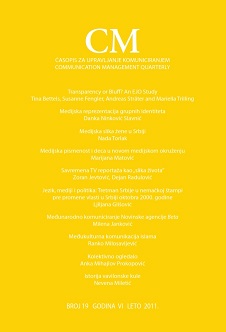Transparency or Bluff? An EJO Study
Transparency or Bluff? An EJO Study
Author(s): Tina Bettels, Susanne Fengler, Andreas Sträter, Mariella TrillingSubject(s): Media studies, Social Informatics, Marketing / Advertising
Published by: Fakultet političkih nauka Univerziteta u Beogradu
Keywords: journalism; audience; participation; editorial process; transparency;
Summary/Abstract: This international comparative study examines whether and in which ways the editorial departments of 12 Western and Eastern European countries allow their readers, listeners and viewers to engage in editorial processes. Are sources revealed and errors corrected? Do editorial departments appoint ombudsmen to act as appeal boards and systematically trace mistakes? Are there blogs, Twitter feeds and social networks utilized by journalists and users to discuss editorial decisions? Moreover, can similarities be found between Western and Eastern European countries, or have variances in journalism cultures led to the emergence of different forms of user involvement in journalistic processes? The results: At present, the editorial departments of many European countries have introduced transparency instruments. For the most part, however, instruments which can be applied with little effort and do not require a great deal of support tend to be utilized. Nearly all of the media reviewed offer commentary functions, links to social networks and photographs of staff. Yet instruments which are time consuming or require resources to engage in dialogue with the public are scarce. Media outlets in Europe rarely invest in ombudsmen and advisory councils, nor do they offer online tools like buttons enabling users to highlight errors in journalistic texts. A large number of European media outlets seem to use transparency instruments primarily for marketing reasons, which creates the illusion that the audience can participate in journalistic processes, but falls short of offering genuine dialogue.
Journal: CM Komunikacija i mediji
- Issue Year: 6/2011
- Issue No: 19
- Page Range: 5-14
- Page Count: 10
- Language: English

